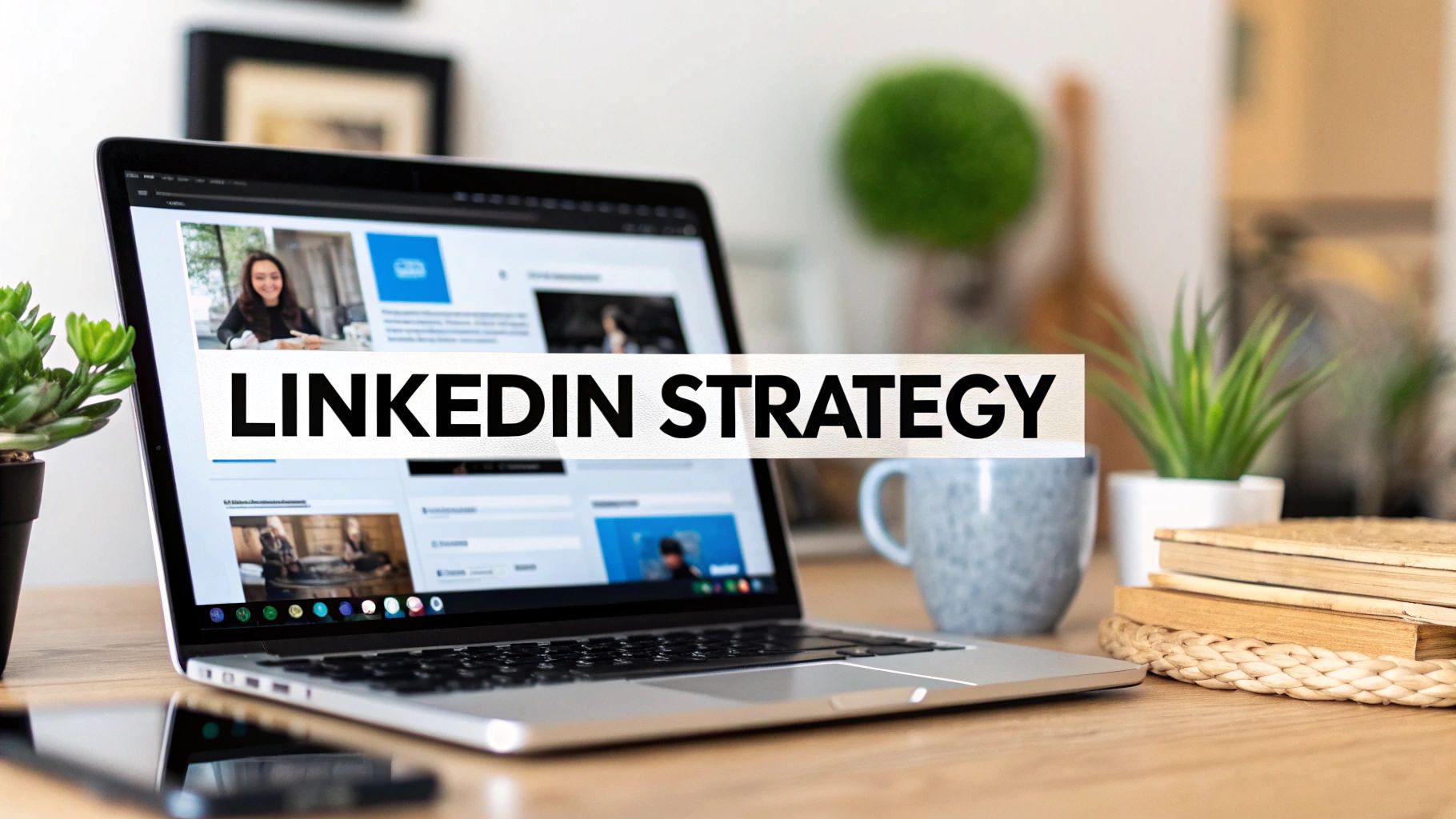
Boost Your LinkedIn Content Strategy for More Engagement
Published on 2025-05-23
Why Your LinkedIn Content Strategy Can't Wait Any Longer
The professional world has changed. LinkedIn isn't just a place to post your resume anymore. It's become the central hub for business networking and thought leadership. Talking with leading marketers reveals a key insight: LinkedIn demands a different content approach than other social media platforms. Traditional social media tactics often fail on LinkedIn because its professional focus creates unique opportunities. Businesses succeeding on LinkedIn are building dedicated strategies, not just reusing content from other platforms. This raises a vital question: are you ready to participate in this evolving professional network?
The Power of a Dedicated LinkedIn Strategy
Why is a dedicated LinkedIn strategy so important? Consider this analogy: you wouldn't wear a business suit to the beach or a swimsuit to a board meeting. Content that works well on Instagram might not connect with LinkedIn's professional audience. That's where a LinkedIn content strategy comes in. It’s about tailoring your message to the right audience and platform. While repurposing content seems efficient, it misses the chance to truly engage with professionals.
LinkedIn’s Explosive Growth and Engagement
LinkedIn’s remarkable growth emphasizes this need for a tailored approach. The platform boasts 1.2 billion members as of early 2025, cementing its place as the top professional social network. Adding roughly 70 million users annually, this expansion provides access to a large and engaged professional audience. Find more detailed statistics here. This growth highlights LinkedIn’s importance in connecting businesses with professionals worldwide, particularly in the US, Europe, and Asia. This makes a strong LinkedIn content strategy not just helpful, but essential.
Capitalizing on LinkedIn’s Professional Audience
User engagement on LinkedIn is significant, with 1.77 billion monthly visits. Users spend an average of 48 hours per month on mobile devices, showcasing the platform's accessibility. With 96% of B2B content marketers already using LinkedIn for distribution, the need for a distinct LinkedIn content strategy is obvious. A strategic approach helps you stand out and deliver targeted content that resonates with decision-makers. It's about building a presence and making a real impact in your industry. Your LinkedIn content strategy isn't about keeping pace—it’s about taking the lead.
Let's take a closer look at some key statistics that demonstrate LinkedIn's impact in the professional world. The following table provides insights into why a dedicated content strategy for this platform is so crucial.
LinkedIn by the Numbers Key statistics demonstrating LinkedIn's significance in the professional networking landscape
| Metric | Value | Significance for Content Strategy |
|---|---|---|
| Total Members | 1.2 Billion | Demonstrates the vast potential audience reach for your content. |
| Annual User Growth | 70 Million | Highlights the platform's continued expansion and the increasing importance of establishing a presence. |
| Monthly Visits | 1.77 Billion | Indicates a high level of user activity and engagement, creating opportunities for content visibility. |
| Average Monthly Mobile Usage | 48 Hours | Shows the platform's accessibility and the need for mobile-optimized content. |
| B2B Content Marketers Using LinkedIn | 96% | Underscores the platform's dominance in B2B content distribution and the importance of a strategic approach to cut through the noise. |
These statistics highlight the immense potential of LinkedIn for reaching and engaging with a professional audience. A well-defined content strategy is essential for leveraging this potential and achieving meaningful results.
Cracking LinkedIn's Unique Engagement Code
LinkedIn is a different beast than other social media platforms. This presents unique challenges and opportunities for professionals looking to connect. Understanding LinkedIn's algorithm is key to unlocking its true potential. This infographic highlights the importance of knowing your audience when creating a content strategy:

As the infographic shows, knowing your audience's professional demographics is essential. This allows you to create targeted content that resonates with their specific needs and interests within your industry. Combining this targeted approach with the right content formats and posting schedule significantly increases your chances of meaningful engagement.
The Counterintuitive Truth About LinkedIn Engagement
Many people believe posting constantly is the key to social media success. However, LinkedIn challenges this assumption. Quality over quantity reigns supreme. LinkedIn's engagement patterns are unique. The platform has over 1 billion members, but only about 1% post weekly. Remarkably, these active users generate 9 billion impressions per week. The average engagement rate is 2.8%, which is high for a professional platform. Explore this topic further. This data highlights that a strategic LinkedIn content strategy focuses on delivering valuable content, not just frequent posts.
Optimizing Content for Maximum Impact
These distinct engagement patterns underscore the importance of content optimization. Video content, for example, receives five times more engagement than text posts. Live video gets an astounding 24 times more interaction than pre-recorded videos. Using diverse content formats, especially video, can significantly amplify your message. Furthermore, hashtags can boost engagement by up to 30%, and humor can increase interaction by 65%.
Beyond Vanity Metrics: Measuring Meaningful Engagement
Getting likes and comments isn't enough. A strong LinkedIn content strategy should focus on generating qualified leads. This involves tracking metrics beyond superficial engagement and prioritizing conversions. For example, how many posts lead to website visits, demo requests, or sales? This deeper analysis helps refine your strategy and ensures your LinkedIn content delivers tangible business results. Employee advocacy also plays a vital role, contributing approximately 30% of a company's total LinkedIn engagement. Empowering your team to share your company's message expands your organic reach significantly.
Let's take a look at how different content formats perform on LinkedIn. The following table summarizes engagement rates and best practices for various content types.
Content Format Performance Comparison: Engagement rates across different content formats on LinkedIn
| Content Format | Average Engagement Rate | Best Practices |
|---|---|---|
| Text Posts | Lower than other formats | Keep it concise, use strong calls to action, ask questions |
| Image Posts | Moderate engagement | Use high-quality images, add descriptive captions |
| Video Posts | 5x more than text | Create short, engaging videos, optimize for mobile viewing |
| Live Video | 24x more than pre-recorded video | Interact with viewers in real-time, promote beforehand |
| Articles | High engagement for in-depth content | Provide valuable insights, use visuals |
| Documents | Good for sharing reports and presentations | Use professional formatting, include key takeaways |
The table above clearly shows the power of visual content on LinkedIn. While text posts are still valuable for sharing quick updates and asking questions, incorporating images, videos, and other rich media formats can significantly boost your engagement. Remember to tailor your content strategy to your specific audience and goals for optimal results.
Building Your LinkedIn Content Calendar That Actually Works
Creating engaging content consistently on LinkedIn takes more than just posting randomly. A well-structured LinkedIn content calendar is key to a successful LinkedIn content strategy. This means understanding when your audience is most active on the platform and scheduling your posts accordingly for maximum visibility. For a deeper dive into this topic, check out this helpful resource: How to master your LinkedIn Content Calendar.
Understanding Your Audience's Rhythm
Think of your LinkedIn content calendar as a well-composed piece of music. Each post plays a part in creating a harmonious whole. The first step is to figure out when your audience is most likely to see your message. Are they browsing LinkedIn during their commute? Maybe they're more active during their lunch break or after work. Pinpointing these peak activity times is essential for optimizing your posting schedule.
Batching and Repurposing for Efficiency
Once you have a good grasp of your audience's online habits, you can start organizing your content creation process. Batching, or creating multiple pieces of content at once, can dramatically boost your efficiency. For instance, you could dedicate one day a week to writing several LinkedIn posts, then another day to creating visuals, and so on. Also, think about repurposing content you've already created. A blog post can be broken down into shorter LinkedIn updates, or a webinar can be turned into a series of quick videos.
The Power of Themed Content Series
Creating themed content series is another great way to keep your audience engaged and build anticipation for what's coming next. Think of it like a TV series. Each episode (or post) adds to a larger story, keeping your audience hooked and coming back for more. This approach also makes content planning easier. Instead of brainstorming individual posts, you can focus on developing broader themes.
Tools and Workflows for Success
Timing and posting frequency are crucial for getting the most out of your content. To streamline your planning, consider using a free online tool like ScheduleThreads' Content Calendar Generator. Studies show brands are posting roughly 18 times per month on LinkedIn, a 10% increase from 2023. The best days to post are Tuesday through Thursday during business hours, with peak engagement happening around mid-morning (10–11 AM) and lunchtime (12–1 PM). Weekends generally see the least amount of engagement. Brands that post weekly or more see double the engagement compared to those who post less consistently. For more detailed stats, check out this resource: LinkedIn Statistics. Whether you’re creating content solo or as part of a team, having the right tools and workflows can simplify managing your LinkedIn content calendar.
Content Formats That Actually Drive Professional Engagement
Your LinkedIn content strategy depends on understanding what truly connects with your audience. It's about selecting the right tools for the job. Just as a plumber wouldn't use a wrench to hammer a nail, you shouldn't depend on a single content format for all your LinkedIn goals. Let's explore the formats that truly excel on this platform.
Text Posts: The Foundation of Conversation
Text posts are fundamental to LinkedIn. They're perfect for starting quick conversations and sharing your immediate thoughts. However, writing effective text posts requires more than just typing out your ideas. It's about structuring your message for maximum impact. This means using short, impactful sentences, asking stimulating questions, and including clear calls to action. Think of each post as a mini-conversation starter.
For example, asking a question like, "What's the biggest challenge you're facing in your industry right now?" can initiate engaging discussions. This encourages interaction and helps build a sense of community among your connections. Keeping your text posts concise and focused will also improve readability.
Images: Adding Visual Appeal to Your Message
The saying, "A picture is worth a thousand words," holds true, especially on LinkedIn. Images make your content more appealing and help break up large blocks of text. Using relevant, high-quality images related to your industry or message can greatly increase engagement.
Consider using images to present data, highlight key takeaways from an article, or simply add a personal touch to your posts. This visual element can be what differentiates a post that gets overlooked from one that grabs a user's attention. Visual content is more likely to be remembered and shared, expanding your reach.
Videos: The Engagement Powerhouse
Videos are arguably the most compelling content format on LinkedIn. They capture attention and allow you to connect with your audience on a more personal level. Short, engaging videos perform very well, particularly those optimized for mobile viewing. This is crucial given the large number of LinkedIn users accessing the platform on their mobile devices.
Consider creating videos that offer quick tips, provide behind-the-scenes looks at your company, or offer thought leadership insights. Live videos are another excellent tool for real-time interaction with your audience. Check out our guide on How to master adding links to your LinkedIn posts to enhance your video content strategy.
Documents: Sharing Valuable Resources and Insights
LinkedIn's document feature provides a distinctive way to share detailed content such as presentations, reports, or white papers. Consider this your chance to offer valuable resources directly to your audience. Creating a content calendar is vital for LinkedIn and other social media platforms. Here's a resource on how to create a social media content calendar.
Well-designed documents with clear takeaways can position you as a thought leader and generate leads. This format is ideal for providing substantial value and showcasing your expertise. Sharing valuable content helps build trust and credibility with your audience.
Choosing the Right Format Mix for Your Goals
Just as a chef uses a variety of ingredients to create a delicious meal, you should use different content formats to achieve your LinkedIn objectives. The key is to find the right combination for your specific audience and goals. Experimenting with different formats will help you determine what resonates most and allows you to refine your LinkedIn content strategy over time. This iterative approach will ensure your content remains engaging and effective.

Building Authentic Thought Leadership That Stands Out

Authenticity is the cornerstone of effective thought leadership on LinkedIn. It's not just about "being yourself," but strategically showcasing your genuine expertise to resonate with your professional audience. This requires moving beyond generic advice and delving into the practical frameworks that drive success.
Identifying Your Unique Perspective
The first step is pinpointing your unique perspective. What specialized knowledge or experience do you offer? What problems can you solve? Consider this your value proposition within your industry. It’s the bedrock of your thought leadership.
For example, in marketing, your unique perspective might be expertise in content marketing or social media advertising. Maybe you've pioneered a unique client management approach or have a proven track record of delivering specific results.
Translating Complex Ideas Into Accessible Insights
Next, translate complex ideas into digestible content. Break down jargon and present information clearly, concisely, and engagingly. Think of yourself as a translator between your industry's complexities and your audience's needs.
Use analogies, examples, and storytelling to make your content relatable and memorable. Show, don't just tell, how these concepts apply to real-world scenarios. This builds trust and solidifies your position as a thought leader. You might be interested in: How to master your LinkedIn thought leadership.
Balancing Credibility and Relatability
Authentic thought leadership balances professional credibility with personal relatability. While showcasing expertise is vital, connect with your audience on a human level. Share experiences, challenges, and even failures in a resonant way.
This vulnerability humanizes your brand and builds genuine connections. It shows you're not just an expert, but a person who understands their challenges. This fosters trust and enhances your credibility.
Developing Your Distinctive Voice
A distinct voice sets you apart. Your voice—the unique blend of your personality, writing style, and perspective—makes your content recognizable.
This isn't about creating a persona. It’s about refining your natural communication style to shine through in your writing. This authenticity connects with your audience on a deeper level, establishing you as a unique voice in your industry.
Creating Content Series That Showcase Your Expertise
Develop a series of LinkedIn posts around a specific topic. This provides consistent value while subtly demonstrating your deep knowledge. It can also build anticipation, encouraging followers to watch for your next installment. This approach provides structure without overt self-promotion.
This is more engaging than one-off posts and positions you as a go-to resource. Remember, genuine thought leadership isn't about self-promotion, but sharing knowledge and helping your audience.
Unleashing Your Team's LinkedIn Advocacy Potential
One of the most effective ways to boost your LinkedIn content strategy is often overlooked: your employees. This section explores how businesses can turn their teams into powerful content amplifiers, while also helping them grow their own professional brands.
Identifying and Empowering Your Advocates
The first step is finding potential advocates within your company. These are people who are passionate about your company and industry, and who are eager to share their knowledge. They're natural brand ambassadors. It's important to give them the right resources and training, without overwhelming them. This could mean creating easy-to-share content templates, offering workshops on LinkedIn best practices, or providing access to content scheduling tools like Buffer.
Providing your sales team with pre-written posts about new product features, for example, makes it easy for them to share updates with their networks. Similarly, giving your customer service representatives templates for answering common industry questions helps them respond quickly and positions them as knowledgeable resources.
Motivation Beyond Mandates
The best employee advocacy programs don't just require participation. Real engagement comes from within. Think about what motivates your employees to use LinkedIn personally and connect your advocacy program to their individual goals. Maybe they want to enhance their professional brand, expand their network, or be seen as thought leaders in their field.
Offering incentives, like recognizing top contributors or giving them opportunities to speak at industry events, can significantly increase participation. Just as a gardener nurtures a plant to help it grow, companies should nurture their employees’ desire to share and engage on LinkedIn.
Balancing Brand Consistency and Authentic Voices
Maintaining brand consistency while letting employees express themselves can be tricky. It's like an orchestra: each musician plays their individual part, but they all follow the same conductor to create a harmonious sound. You can achieve this balance by establishing clear brand guidelines and providing content templates with room for personalization.
Encouraging employees to share their personal experiences and perspectives, within company policy, makes their posts more authentic and relatable. This genuine approach builds real engagement and expands the reach of your brand message.
Measuring Program Effectiveness
Measuring the success of your employee advocacy program means looking beyond simple metrics like likes and shares. These metrics offer some insights, but they don't tell the whole story. Instead, focus on measurable results that align with your business objectives. How many leads came from employee posts? Did website traffic increase? Did brand awareness improve within your target market?
Tracking these metrics allows you to show the value of your advocacy program and adjust your strategy as needed. This data-driven approach ensures your program stays aligned with your business goals and delivers real results.
Handling Compliance in Regulated Industries
For companies in regulated industries, compliance is essential. Employee advocacy programs must follow strict guidelines about what information can be shared. This means providing thorough training on compliance regulations and ensuring all employee-shared content follows these rules. This proactive approach reduces risks and protects your company's reputation.
Creating Sustainable Advocacy
Sustainable employee advocacy programs benefit both the company and the employees involved. This means providing ongoing support, resources, and recognition to keep employees motivated and engaged. Regularly evaluating and adapting the program based on feedback and results ensures its long-term success. Like a thriving garden, a successful employee advocacy program requires ongoing care and attention.
Ready to transform your LinkedIn presence and empower your team? Explore how autoghostwriter.com can elevate your LinkedIn content strategy and unlock the potential of employee advocacy.